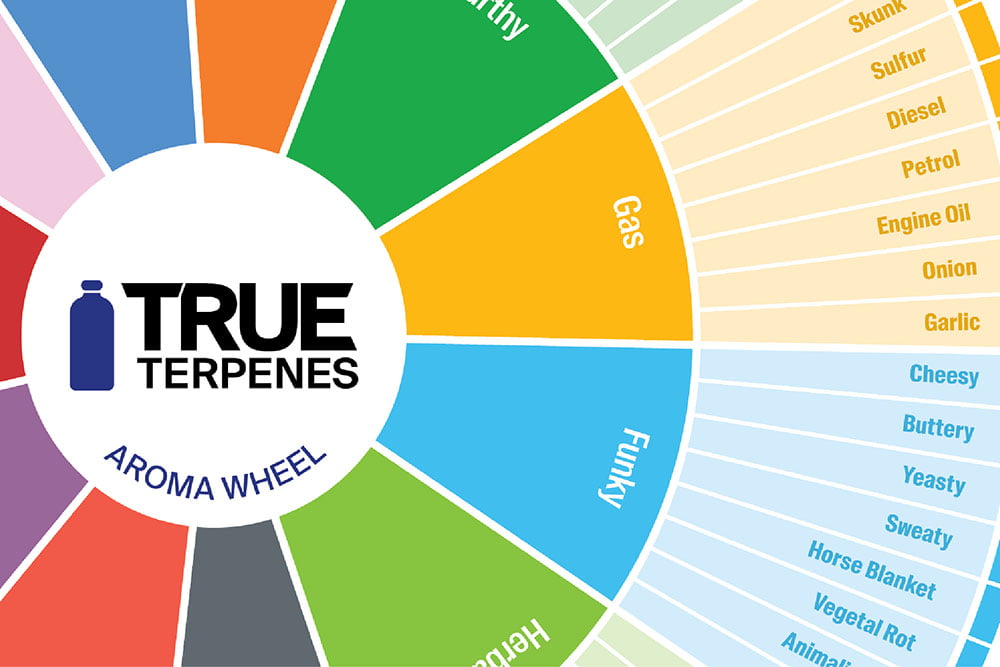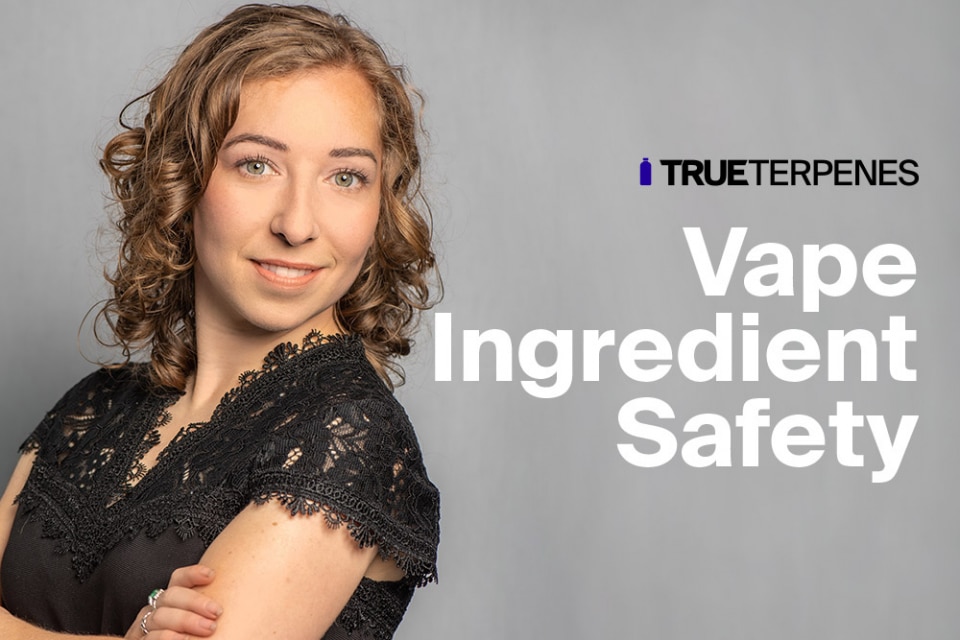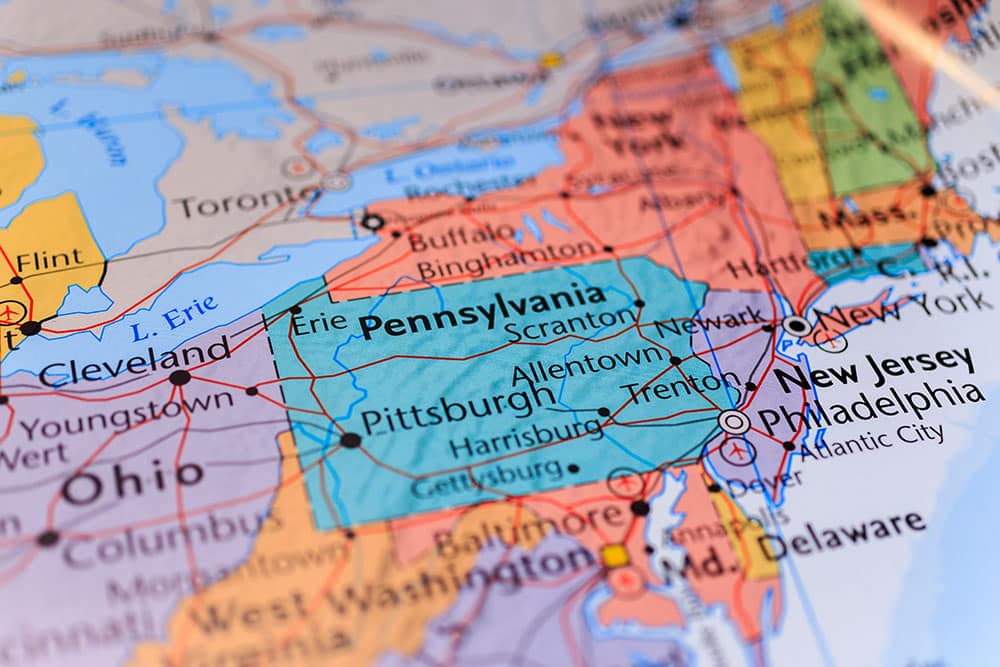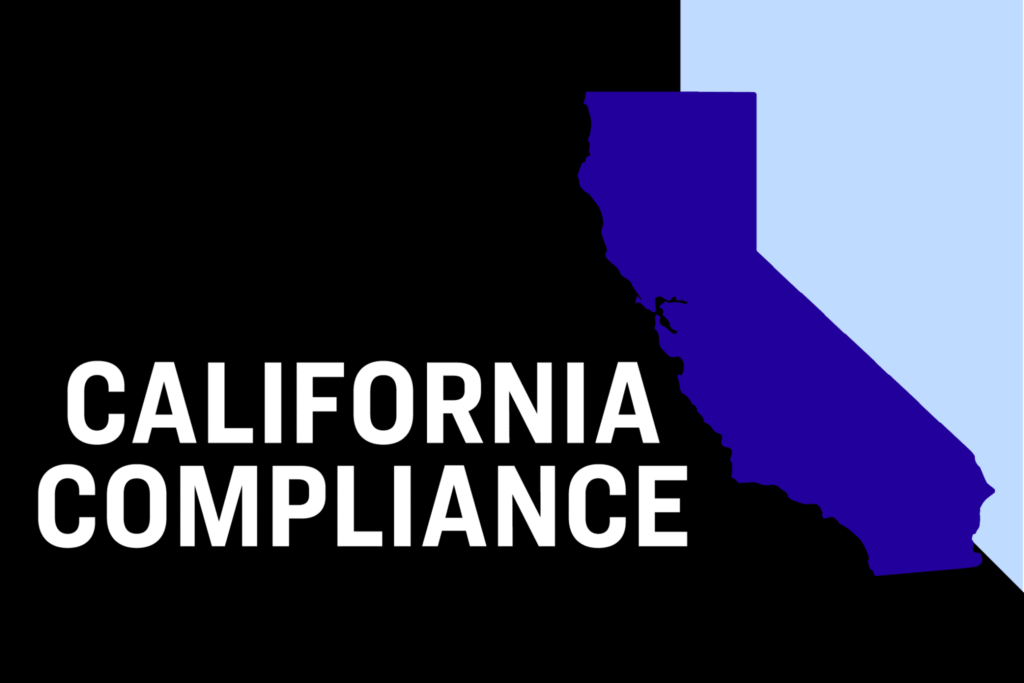March 26, 2020
The Entourage Effect
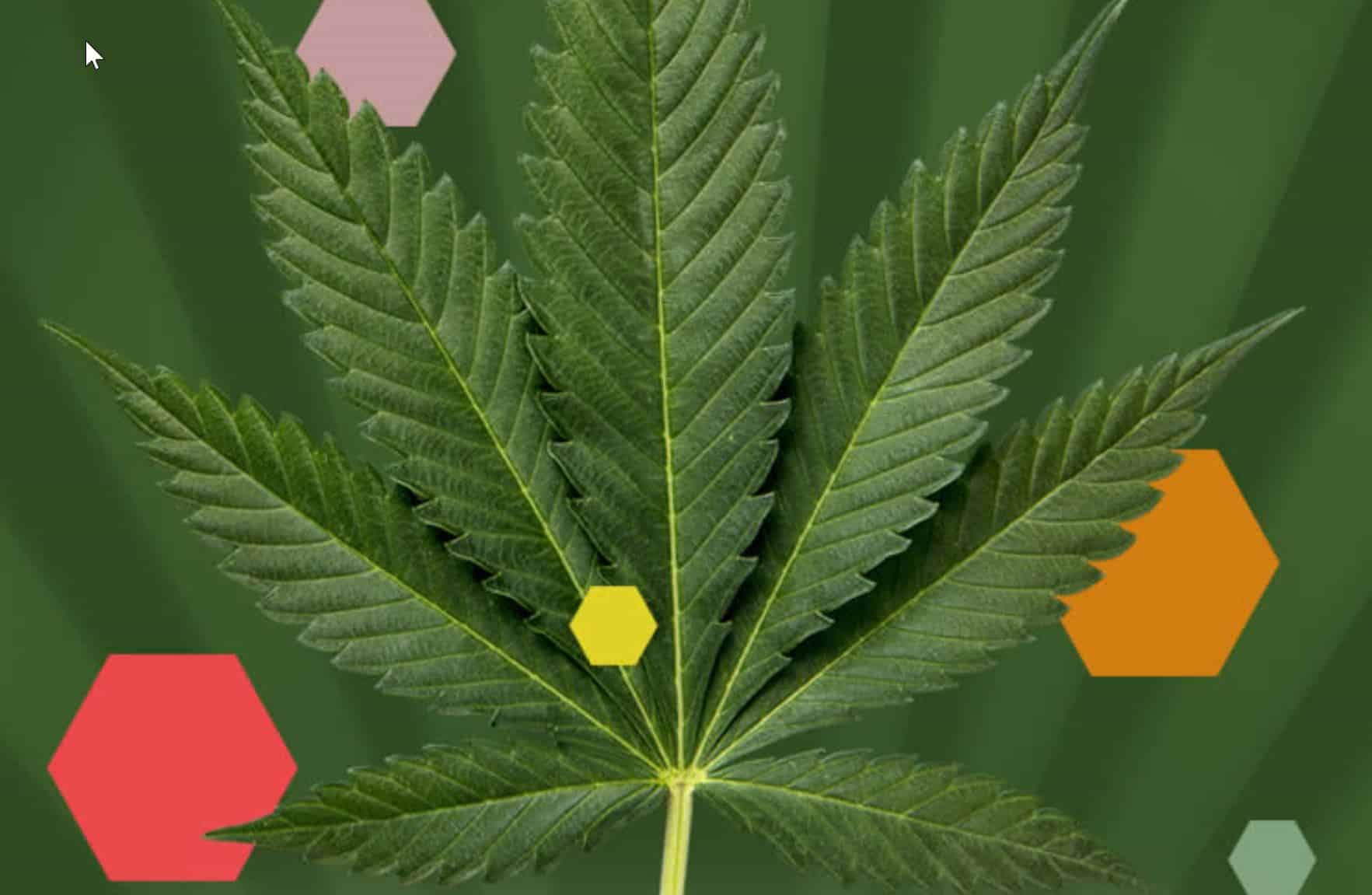
This article about the entourage effect is for educational purposes only. This is not meant to diagnose, treat or otherwise represent advice on a medical condition and does not constitute medical advice. Talk to your doctor about all medical questions. This is only a review on research documents.
What is the entourage effect?
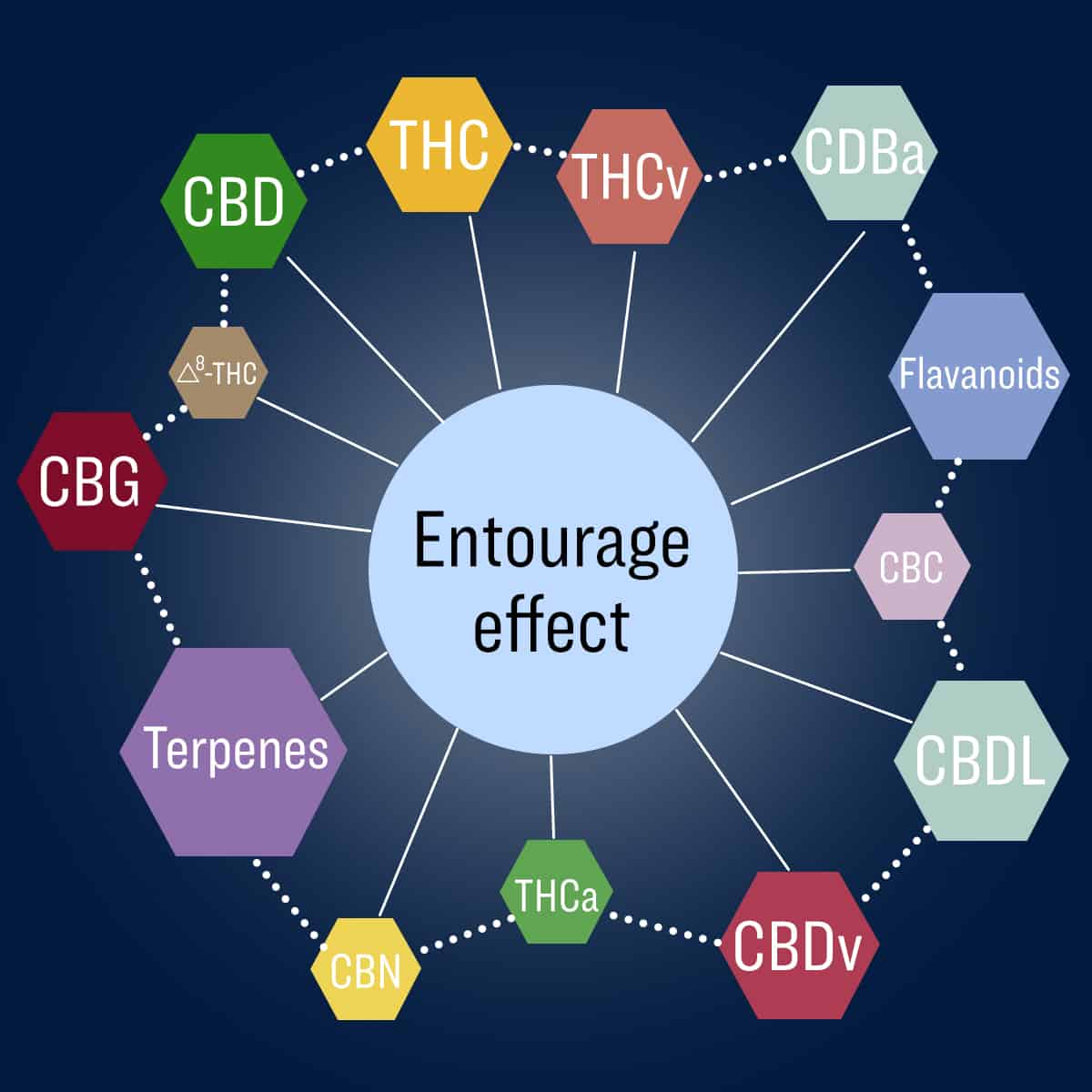
The Entourage Effect is essentially a unified theory on how the various compounds in cannabis and our bodies interact synergistically to create the variety of therapeutic and subjective effects the plant is famous and infamous for. These interactions occur through a variety of systems in our bodies.
How does cannabis work? Why does this variety or strain make me feel the way I do? Why is there so much variation in research on medical cannabis?
The answer to all of these questions is the Entourage Effect.
For most of the last 100 years we have been concerned primarily with Tetrahydrocannabinol (THC) and its use as an intoxicant or medicine in the United States. Recently, incredible work by scientists has demonstrated the benefits of cannabidiol (CBD). The science has advanced so far that the US federal government legalized the production of hemp at the end of 2018. The US Food and Drug Administration (FDA) has approved the use of cannabis-derived CBD as a medicine and topical products abound, while we are waiting on federal guidelines for CBD foods and supplements.
However, THC and CBD aren’t even the only cannabinoids: cannabigerol (CBG), cannabichromene (CBC), tetrahydrocannabivarin (THCV), cannabivarin (CBDV), cannabinol (CBN) and more exist for example. Beyond cannabinoids the plant contains dozens of other compounds including: terpenes, terpenoids, flavonoids, anthocyanins and more. Further, every cultivar of cannabis has its own unique mixture of these compounds. There is a complex mixture of hundreds of compounds in every plant.
How the Entourage Effect Relates to the Endocannabinoid System
The system most associated with cannabis in the human body is the EndoCannabinoid system (ECS). The ECS is a system of receptors throughout the human body which serves to regulate homeostasis and the body’s functions such as sleep, appetite and the immune system.
There are two endocannabinoid receptor types: cannabinoid receptor 1 (CB1) and 2 (CB2). The CB1 receptor is primarily known for its role in the psychoactivity of CB1 agonist THC, but it’s also indicated in pain relief and sleep. The CB2 receptors are most densely located in the digestive and immune systems, but are found throughout the body.
The ECS acts similarly to endorphins relieving pain and providing a runner’s high through acting on the opiate receptors. Compounds known as endocannabinoids, literally cannabinoids from within, such as anandamide, oleoylethanolamide and 2-arachidonoylglycerol bind to one or both of the receptors to create varying effects. Anandamide for example an agonist, or compound that binds to a receptor and activates it to create a biological effect, for CB1 and CB2 receptors similarly to THC. It is also known for creating an intoxicating effect and is named after the sanskrit word “ananda” which means “bliss”.
Whereas an agonist causes an action, an antagonist blocks the action of the agonist and an inverse agonist causes an action opposite to that of the agonist.
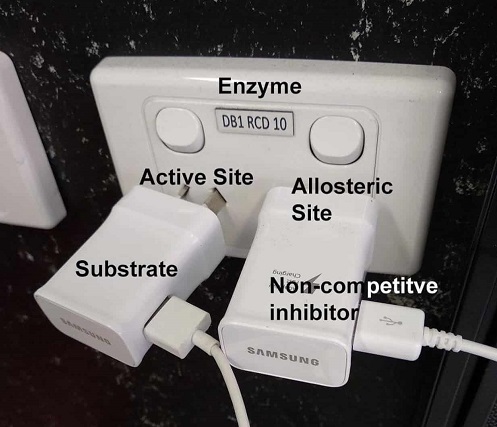
A good example of these principals is the compound THCV. THCV has a shorter side chain than THC, being a propyl vs pentyl (3 vs 5 carbons) in structure. At high doses, 7mg IV human dose, THCV has been shown to help with pain via CB1 agonism. It also behaves as an antagonist blocking some of the action of THC in some studies at lower concentrations, while some data shows it may act as an inverse agonist actually acting oppositely of THC. A 2015 study documented that when added to THC (1 mg), THCV (10 mg) reduced negative effects on verbal memory and heart rate. [1] Other data has shown the possibility to reduce obesity and body size in mice. [2]
Figure 1: Allosteric Modulation demonstrated by power supplies. Read below for details.
CBD adds another wrinkle into this process. It was initially thought to act as an antagonist at the CB1 and CB2 receptors because it seemed to block some of the activity there. However, newer data is showing that CBD is likely actually a non-competitive inhibitor/allosteric modulator for these receptors. [3, 4]
Receptors, such as CB1 and CB2, have orthosteric or active sites which are where agonists, antagonists and inverse agonists bind. They also often are being shown to have allosteric or secondary binding sites. When a compound binds to an allosteric site it can alter the shape of the orthosteric site which can either increase or decrease the agonist activity at the orthosteric site. A good visual for this is when two power cords are plugged into an outlet and one is shaped in a way to push the other out of the outlet. The plug preventing the other from charging is effectively acting as a non-competitive inhibitor/ allosteric modulator (Figure 1).
As an allosteric modulator CBD reduces the strength of binding and activity of THC at CB1 and Cannabichromene (CBC) at CB2. CBC is a selective CB2 agonist. [5] CBD has been shown to reduce the increased appetite driven by THC when coadministered. [6]
The Terpenes Entourage Effect, Non-Cannabinoids and the ECS
The ECS is also modulated by a variety of the other compounds identified in the cannabis plant. Terpenes are hydrocarbons which are responsible for the scent and taste of plants like lavender (linalool, myrcene, beta-caryophyllene). They’re also responsible for the various effects of those plants including lavender. There are hundreds of terpenes and related compounds found in the cannabis plant.
Several terpenes have now been shown to act directly on the cannabinoid receptors themselves. Beta-caryophyllene was the first terpene to be identified as a cannabinoid receptor ligand. It works as a CB2 agonist in the human body. [7] Humulene and alpha terpineol were identified as CB2 ligands during a study on the antimicrobial effect of cannabis essential oil. [8] Citral has been shown to work via the CB2 receptor as well. [9] So far all of these terpenes have shown activity on the CB2 receptor, but we have no data on a terpene which is a CB1 ligand.
However, a variety of other cannabis native compounds have been shown to act on both the CB1 and CB2 receptors. Ursolic acid, a triterpenoid, and the flavonoid quercetin are found in cannabis and other plants and are both active on the CB1 receptor. [10]
Anthocyanins are a type of flavonoid responsible for the red, blue colors in plants like grapes, strawberries, blueberries and even cannabis are also active on the CB1 and CB2 receptors. Cyanidin, Delphinidin, Pelargonidin, Malvidin and Peonidin (listed in descending order of binding strength) are anthocyanins with activity on the CB1/2 receptors. [11]
While ursolic acid, quercetin, terpenes and anthocyanins are found in plants besides cannabis, It turns out there are even fungi that have activity on the CB1/2 receptors. Cordyceps annullata has shown to have activity on both the CB1/2 receptors. Several annullatin-like compounds were identified which had agonist action on the CB1 receptor, but a mixture of inverse agonist and agonist activity on the CB2 receptor. [12] Turkey tail mushrooms (Trametes versicolor) contain a CB2 agonist as well, which was shown to be linked to pain reduction and reduction of morphine tolerance. [13]
Mechanisms of Entourage Effect
There are a few main ideas/concepts/theories around how the entourage effect works. Some have theorized that the entourage effect is driven through the additive effect of cannabinoids, terpenes and other phytochemicals acting on the ECS in a synergistic manner. For example, CBD or THCV decreasing specific effects of THC in a treatment could be an example of this. However, this would only explain a small portion of the subjective effects that have been observed.
Myrcene has long been thought to influence the subjective effects of cannabis like couchlock. Many have theorized that the mechanism for this was linked to either an increase of the ability for THC to bind at the CB1 or increasing penetration of THC into the blood-brain barrier.
A study done in 2010 with 3 cultivars of cannabis looked at whether the vapor or smoke of the entire metabolite profile would affect binding at the CB1 receptors. They found no difference in the receptor activity with pure THC compared to 3 different varieties of cannabis at an equivalent concentration of THC. [14]
Further evidence of a lack of synergistic action on the ECS by terpenes and cannabinoids is found in an investigation on the CB1 and CB2 binding of CB1 agonists with the terpenes: alpha-pinene, beta-pinene, beta-caryophyllene, limonene, linalool and myrcene each independently or in combination. They similarly found no additive effect on CB1 or CB2 activity with terpenes. [15] The same scientists followed this study up by repeating the process, but this time trying the Transient Receptor Potential Channels A and V (TRPA/V) with alpha-pinene, beta-pinene, beta-caryophyllene, humulene, limonene, linalool and myrcene. THC is active on TRPA, but they weren’t able to identify any synergistic activity with any of the terpenes at the channels. No cannabinoid (CBC, CBD, CBDA, CBG, CBGA, CBGV, THC, THCA) was active on TRPV1 channels so they utilized the endocannabinoid anandamide and capsaicin for comparison. Again there was no synergistic activity at the channels through addition of the terpenes [16] This is interesting considering there is data showing that myrcene is a potential allosteric modulator of TRPV. [17] Terpenes are not strong enough to impact an already strong agonist binding activity it appears.
This doesn’t mean that there aren’t synergistic therapeutic or subjective effects from the combination of multiple compounds found in the cannabis plant. It means the answer for how terpenes impact these effects lies less with affecting how a cannabinoid binds to the CB1 or CB2 receptors and more with how they act on other receptors or drug targets.
What other receptor systems are involved in the entourage effect?
5-Hydroxytryptamine Receptors (5HT)
The 5HT receptors form the serotonin system in our bodies and brains. There are a series of receptors from 5HT1 to 5HT7 as well as several subtypes of each. There are at least 13 total variations. The serotonin system is often linked with mood, learning, happiness, sleep but it’s also connected to digestion and nausea.
The 5HT1 receptors have been shown as targets for increasing emotional response. Beta caryophyllene [18], linalool [19] and limonene all have activity on 5HT1A. CBD both an agonist for 5HT1A [20] and an antagonist for 5HT3 [21]. Many 5HT3 receptor antagonists are also antiemetics helping prevent nausea and vomiting. Studies have shown citral, eucalyptol and linalool [22] as well as b-eudesmol inhibit 5HT3 signaling [23].
Some information is beginning to show synergistic action between the CB1 receptors and the 5HT2 [24] or 5HT3 [25] receptors. The 5HT2 receptors even form pairs with CB1 receptors that can be triggered by ligands of either receptor. This helps explain how some compounds with no direct cannabinoid receptor agonism may trigger their activity or downstream synergy.
Dopamine
The dopamine receptors as the name indicates are endogenously activated by dopamine. This system regulates motivation, pleasure, cognition, memory, learning, and fine motor control. There are 5 dopamine receptors numbered D1-5. The dopamine receptors similarly to the serotonin system will form heteromers or pairs with CB1 receptors and 3-way systems that additionally incorporate the adenosine receptors. Interestingly when a CB1 agonist and dopamine agonist are introduced to a CB1/D2 heteromer at the same time they reduce the binding affinity for each other. [26] The terpenes eudesmol [27] and pulegone [28] are dopamine agonists that could be used for a similar effect.
Gamma Amino Butyric Acid Receptors (GABA)
GABA receptors are responsible for inhibitory signaling in the brain. GABA signaling is often associated with sedation, anxiety relief and preventing seizures. Traditional prescription drugs such as benzodiazepines or barbiturates both increase GABA signaling and act as positive allosteric modulators and agonists for the receptors.
CBD and the endocannabinoid 2-AG are both positive allosteric modulators of the GABA receptors. Linalool and many of its metabolic derivatives are agonists for the GABA receptors. Linalool [29], Alpha pinene [30], Borneol [31], terpineol [32], nerolidol [33] and other terpenes are also effective on the GABA system.
Cytochrome P450
In addition to activity on the various receptors some cannabinoids and terpenes are also able to inhibit cytochrome p450 enzymes. Cytochrome p450 enzymes are a large family of enzymes found primarily in the liver, but also throughout the body which break down compounds in the body from hormones and endocannabinoids to terpenes or prescription drugs.
Cannabinoids such as CBD, THC and CBN have been shown to inhibit several of the cytochrome p450 enzymes. [34] CBD has the strongest activity of these cannabinoids on cytochrome and can slow the metabolism of THC which is metabolized by these same enzymes. Beta-Caryophyllene, caryophyllene oxide and humulene were also shown to block the cytochrome p450 enzymes. [35] The cytochrome inhibition occurs primarily through oral consumption and may explain some of the cannabis and terpene interactions/synergy in oral formulations. While cytochrome inhibition is something to be aware of, it can be used to potentiate the bioavailability of low concentration compounds. This could have therapeutic benefits in some treatments.
Conclusion
There are many other potential receptor targets which can explain the interplay between the many compounds that are found in the cannabis plant and the human body. However, much of this evidence even presented here is derived from animal and cell studies. While helpful much more research is needed to help explain the entourage effect.
Luckily the National Institute of Health has offered grants to researchers to study the effects of terpenes and minor cannabinoids such as CBG, CBGV, CBDV or THCV. [36] The UCLA researcher Ziva Cooper was awarded one of these grants to investigate combinations of beta caryophyllene and myrcene with either THC or opiates. The goal is to see if the terpenes can reduce the dosage and side effects of both THC and opiates. Even more exciting is that Cooper will be utilizing True Terpenes myrcene and beta-caryophyllene for her research. [37] At True Terpenes we hope science and the cannabis plant can continue to help the world through the entourage effect.
References
- [1] https://journals.sagepub.com/doi/abs/10.1177/0269881115615104
- [2] https://www.nature.com/articles/nutd20139
- [3] https://bpspubs.onlinelibrary.wiley.com/doi/full/10.1111/bph.13250
- [4] https://www.frontiersin.org/articles/10.3389/fphar.2017.00744/full
- [5] https://bpspubs.onlinelibrary.wiley.com/doi/abs/10.1111/bph.14815
- [6] https://www.nature.com/articles/npp201058
- [7] https://www.pnas.org/content/105/26/9099.short
- [8] https://www.thieme-connect.com/products/ejournals/abstract/10.1055/s-0034-1382491
- [9] https://pubs.acs.org/doi/pdf/10.1021/acs.jnatprod.9b01134
- [10] https://www.sciencedirect.com/science/article/pii/S1319016417302256
- [11] https://www.liebertpub.com/doi/abs/10.1089/jmf.2008.0243
- [12] https://www.sciencedirect.com/science/article/pii/S0040403912003255
- [13] https://www.sciencedirect.com/science/article/pii/S0141813018360422
- [14] https://www.ncbi.nlm.nih.gov/pubmed/20118579
- [15] https://www.biorxiv.org/content/10.1101/569079v1
- [16] https://www.liebertpub.com/doi/full/10.1089/can.2019.0099
- [17] https://www.tandfonline.com/doi/full/10.1080/19336950.2019.1654347
- [18] https://www.sciencedirect.com/science/article/pii/S027858461200084X
- [19] https://www.sciencedirect.com/science/article/abs/pii/S0024320515001381
- [20] https://www.ncbi.nlm.nih.gov/pmc/articles/PMC2697769/
- [21] https://www.ncbi.nlm.nih.gov/pubmed/20160007
- [22] https://www.ncbi.nlm.nih.gov/pmc/articles/PMC5378937/
- [23] https://www.sciencedirect.com/science/article/abs/pii/S037887411200116X
- [24] https://www.ncbi.nlm.nih.gov/pubmed/26158621
- [25] https://www.ncbi.nlm.nih.gov/pubmed/26701293
- [26] https://www.sciencedirect.com/science/article/abs/pii/S0028390808000026
- [27] https://www.sciencedirect.com/science/article/abs/pii/S037887411200116X
- [28] https://www.degruyter.com/view/j/znc.2011.66.issue-7-8/znc-2011-7-806/znc-2011-7-806.xml
- [29] https://www.frontiersin.org/articles/10.3389/fchem.2017.00046/full
- [30] https://molpharm.aspetjournals.org/content/90/5/530
- [31] https://www.sciencedirect.com/science/article/abs/pii/S0006295205000341
- [32] https://www.hindawi.com/journals/omcl/2014/703848/
- [33] https://onlinelibrary.wiley.com/doi/abs/10.1111/fcp.12166
- [34] https://www.sciencedirect.com/science/article/abs/pii/S0024320511000920
- [35] https://www.sciencedirect.com/science/article/abs/pii/S000927971730491X
- [36] https://nccih.nih.gov/news/press/09192019
- [37] https://newsroom.ucla.edu/dept/faculty/scientist-receives-3-9m-grant-to-study-whether-certain-cannabis-chemicals-can-help-with-pain
